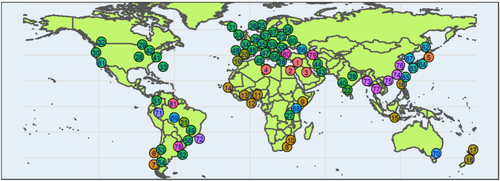Announcements
We are recruiting recommenders (editors) from all research fields!
Your feedback matters! If you have authored or reviewed a Registered Report at Peer Community in Registered Reports, then please take 5 minutes to leave anonymous feedback about your experience, and view community ratings.
Latest recommendations

| Id | Title | Authors | Abstract | Picture▲ | Thematic fields | Recommender | Reviewers | Submission date | |
|---|---|---|---|---|---|---|---|---|---|
17 Jan 2023
STAGE 1

Similarities and differences in a global sample of song and speech recordingsCorresponding authors: Yuto Ozaki and Patrick E. Savage (Keio University, Japan). Full list of 80 authors is in the manuscript https://psyarxiv.com/jr9x7Exploring cross-cultural variation in speech and songRecommended by Chris Chambers based on reviews by Bob Slevc, Nai Ding and 1 anonymous reviewer based on reviews by Bob Slevc, Nai Ding and 1 anonymous reviewer
For centuries, the ubiquity of language and music across human societies has prompted scholars to speculate about their cross-cultural origins as well as their shared and unique characteristics. Depending on the extent to which contemporary theories emphasise the role of biology vs. culture, a range of hypotheses have been proposed concerning expected similarities and differences in song and speech. One class of hypotheses stemming from cultural relativism assumes a lack of universal regularities in song and speech, and therefore predicts no systematic cross-cultural relationships. On the other hand, more recent evolutionary hypotheses such as the social bonding hypothesis, motor constraint hypothesis, and sexual selection hypothesis all predict differences or similarities in specific characteristic of vocalisations, such as pitch regularity, pitch interval size, and melodic contour. Existing results are mixed in their support of these predictions.
In the current study, Ozaki et al. (2022) embark on an ambitious project to elucidate cross-cultural similarities and differences between speech and song in 81 different linguistic varieties spanning 23 language families. Understanding precisely how song and speech are related is methodologically challenging due to the multitude of confounds that can arise in comparing natural recordings. Here the authors overcome these difficulties with four types of carefully controlled recordings: singing, recitation of sung lyrics, spoken description of the song, and instrumental version of the sung melody. The authors will then examine six features that are amenable to reliable comparison, including pitch height, temporal rate, pitch stability, timbral brightness, pitch interval size, and pitch declination. With this data in hand, the authors will ask which acoustic features differ reliably between song and speech across cultures, with the expectation that song will exhibit higher pitch, slower rate and more stable pitch than speech. At the same time, the authors expect song and speech to be reliably similar in the characteristics of timbral brightness, pitch intervals and pitch contours. In addition to these confirmatory tests, the authors will explore variation across a range of additional stimulus characteristics and ancillary research questions.
The Stage 1 manuscript was evaluated over two rounds of in-depth review. Based on detailed responses to the reviewers' comments, the recommender judged that the manuscript met the Stage 1 criteria and therefore awarded in-principle acceptance (IPA).
URL to the preregistered Stage 1 protocol: https://osf.io/jdhtz
Level of bias control achieved: Level 2. At least some data/evidence that will be used to answer the research question has been accessed and partially observed by the authors, but the authors certify that they have not yet observed the key variables within the data that will be used to answer the research question AND they have taken additional steps to maximise bias control and rigour.
List of eligible PCI RR-friendly journals: References
1. Ozaki, Y., Savage P. E. et al. (2022). Similarities and differences in a global sample of song and speech recordings, in principle acceptance of Version 2 by Peer Community in Registered Reports. https://osf.io/jdhtz
| Similarities and differences in a global sample of song and speech recordings | Corresponding authors: Yuto Ozaki and Patrick E. Savage (Keio University, Japan). Full list of 80 authors is in the manuscript | <p>What, if any, similarities and differences between song and speech are consistent across cultures? Both song and speech are found in all known human societies and are argued to share evolutionary roots and cognitive resources, yet no studies ha... |  | Social sciences | Chris Chambers | Bob Slevc, Nai Ding | 2022-09-16 16:03:10 | View |
17 Jan 2022
STAGE 1

Identifying Gaming Disorders by Ontology: A Nationally Representative Registered ReportVeli-Matti Karhulahti, Jukka Vahlo, Marcel Martončik, Matti Munukka, Raine Koskimaa, Mikaela von Bonsdorff https://osf.io/mpz9q/Do different screening instruments for ‘gaming disorder’ measure the same or different construct(s)?Recommended by Charlotte Pennington based on reviews by Daniel Dunleavy, Linda Kaye, David Ellis and 1 anonymous reviewer based on reviews by Daniel Dunleavy, Linda Kaye, David Ellis and 1 anonymous reviewer
There is considerable debate regarding the relationship between excessive gaming and mental health problems. Whilst the diagnostic classification of “gaming disorder” has now been included in the WHO’s International Classification of Diseases (ICD-11), the APA decided not to include this diagnosis in their Diagnostic and Statistical Manual of Mental Disorders (DSM-5) because the literature “suffers from a lack of a standard definition from which to derive prevalence data” (APA 2013, p. 796). Furthermore, screening instruments that aim to provide diagnostic classifications derive from different ontologies and it is not known whether they identify equivalent prevalence rates of ‘gaming disorder’ or even the same individuals. In this Stage 1 Registered Report, Karhulahti et al. (2022) aim to assess how screening instruments that derive from different ontologies differ in identifying associated problem groups. A nationally representative sample of 8000 Finnish individuals will complete four screening measures to assess the degree of overlap between identified prevalence (how many?), who they identify (what characteristics?) and the health of their identified groups (how healthy?). If these four ontologically diverse instruments operate similarly, this will support the notion of a single “gaming disorder” construct. If, however, the instruments operate differently, this will suggest that efforts should be directed toward assessing the clinical (ir)relevance of multiple constructs. This rigorous study will therefore have important implications for the conceptualisation and measurement of “gaming disorder”, contributing to the debate around the mixed findings of gaming-related health problems. Four expert reviewers with field expertise assessed the Stage 1 manuscript over three rounds of in-depth review. Based on detailed and informed responses to the reviewers' comments, the recommender decided that the manuscript met the Stage 1 criteria and therefore awarded in-principle acceptance (IPA). URL to the preregistered Stage 1 protocol: https://osf.io/usj5b Level of bias control achieved: Level 6. No part of the data or evidence that will be used to answer the research question yet exists and no part will be generated until after IPA. List of eligible PCI RR-friendly journals:
References
| Identifying Gaming Disorders by Ontology: A Nationally Representative Registered Report | Veli-Matti Karhulahti, Jukka Vahlo, Marcel Martončik, Matti Munukka, Raine Koskimaa, Mikaela von Bonsdorff | <p style="text-align: justify;">Gaming-related health problems have been researched since the 1980s with numerous different “ontologies” as reference systems, from self-assessed “game addiction” to “pathological gambling” (in the DSM-IV), “interne... |  | Medical Sciences, Social sciences | Charlotte Pennington | 2021-08-25 23:08:26 | View | |
25 Mar 2024
STAGE 1

Assessing compliance with UK loot box industry self-regulation on the Apple App Store: a 6-month longitudinal study on the implementation processLeon Y. Xiao https://osf.io/7xft9Does self regulation by gaming companies for the use of loot boxes work?Recommended by Zoltan Dienes based on reviews by Chris Chambers, Lukas J. Gunschera and Andy Przybylski based on reviews by Chris Chambers, Lukas J. Gunschera and Andy Przybylski
Video games may provide the option of spending real money in exchange for probabilistically receiving game-relevant rewards; in effect, encouraging potentially young teenagers to gamble. The industry has subscribed to a set of regulatory principles to cover the use of such "loot boxes", including 1) that they will prevent loot box purchasing by under 18s unless parental consent is given; 2) that they will make it initially clear that the game contains loot boxes; and 3) that they will clearly disclose the probabilities of receiving different rewards.
Can the industry effectively self regulate? Xiao (2024) will evaluate this important question by investigating the 100 top selling games on the Apple App Store and estimating the percentage compliance to these three regulatory principles at two time points 6 months apart.
The Stage 1 manuscript was evaluated over one round of in-depth review. Based on detailed responses to the reviewers' comments, the recommender judged that the manuscript met the Stage 1 criteria and therefore awarded in-principle acceptance (IPA).
URL to the preregistered Stage 1 protocol: https://osf.io/3knyb
Level of bias control achieved: Level 2. At least some data/evidence that will be used to answer the research question has been accessed and partially observed by the authors, but the authors certify that they have not yet observed the key variables within the data that will be used to answer the research question. List of eligible PCI RR-friendly journals:
References 1. Xiao, L. (2024). Assessing compliance with UK loot box industry self-regulation on the Apple App Store: a 6-month longitudinal study on the implementation process. In principle acceptance of Version 3 by Peer Community in Registered Reports. https://osf.io/3knyb | Assessing compliance with UK loot box industry self-regulation on the Apple App Store: a 6-month longitudinal study on the implementation process | Leon Y. Xiao | <p>Loot boxes in video games can be purchased with real-world money in exchange for random rewards. Stakeholders are concerned about loot boxes’ similarities with gambling and their potential harms (e.g., overspending). The UK Government has decid... |  | Humanities, Social sciences | Zoltan Dienes | 2023-08-27 22:47:03 | View | |
Is the past farther than the future? A registered replication and test of the time-expansion hypothesis based on the filling rate of durationQinjing Zhang, Yoshitaka Masuda, Kodai Toda, Kohei Ueda, Yuki Yamada https://doi.org/10.31234/osf.io/pb47nThe Temporal Doppler Effect may not be a robust and culturally universal phenomenonRecommended by Ljerka Ostojic based on reviews by Chris Chambers and 1 anonymous reviewer based on reviews by Chris Chambers and 1 anonymous reviewer
The Temporal Doppler Effect refers to the subjective perception that the past is further away than the future even when both temporal distances are objectively the same from the present moment (Caruso et al., 2013). In the current study, Zhang et al. ran a replication of this phenomenon and tested one possible explanation for it, namely that people overestimate the temporal distance of the past because the past is filled with more events than the future. This is because we can access information only about planned events for the future, but have access to both planned and unplanned events that happened in the past (filled-duration illusion; Thomas & Brown, 1974).
Over two studies, the authors found that the sampled participants reported feeling that the past was psychologically closer than the future, which is the opposite of what has previously been reported and termed the Temporal Doppler Effect (Caruso et al., 2013). In addition, the authors reported inconsistent results regarding the correlations between the psychological distance and different variables associated with the filling rate of duration. The authors discuss the differences between their own results and those by Caruso et al. (2013) in terms of methodological and contextual differences and highlight cultural aspects that may be critical to consider in future replications and overall testing of this phenomenon. As such, they highlight that, at the moment, the Temporal Doppler Effect should not be considered a robust and culturally universal phenomenon.
The Stage 2 manuscript was evaluated by two reviewers who had also reviewed the stage 1 report. Following a revision by the authors, which consisted of adding the Data Availability statement, as well as a more precise summary of the results in various sections of the report, the recommender judged that the manuscript met the Stage 2 criteria and awarded a positive recommendation.
URL to the preregistered Stage 1 protocol: https://osf.io/d9ec3/
Level of bias control achieved: Level 6. No part of the data or evidence that was used to answer the research question existed prior to Stage 1 in-principle acceptance. List of eligible PCI RR-friendly journals:
References
1. Caruso, E. M., Van Boven, L., Chin, M., & Ward, A. (2013). The temporal doppler effect: When the future feels closer than the past. Psychological Science, 24, 530-536. https://doi.org/10.1177/0956797612458804
2. Thomas, E. C., & Brown, I. (1974). Time perception and the filled-duration illusion. Perception & Psychophysics, 16, 449-458. https://doi.org/10.3758/BF03198571
3. Zhang, Q., Masuda, Y., Ueda, K.,Toda, K., & Yamada, Y. (2022). Is the past farther than the future? A registered replication and test of the time-expansion hypothesis based on the filling rate of duration. Stage 2 Registered Report, acceptance of Version 2 by Peer Community in Registered Reports. https://psyarxiv.com/pb47n/
| Is the past farther than the future? A registered replication and test of the time-expansion hypothesis based on the filling rate of duration | Qinjing Zhang, Yoshitaka Masuda, Kodai Toda, Kohei Ueda, Yuki Yamada | <p>People feel some events to be psychologically closer, while others to be farther away. Caruso et al. (2013) reported the Temporal Doppler Effect (TDE), in which people feel that the past is farther than the future, despite an equivalent objecti... |  | Social sciences | Ljerka Ostojic | 2022-08-20 09:59:09 | View | |
29 Jun 2022
STAGE 1

Go above and beyond: Does input variability affect children’s ability to learn spatial adpositions in a novel language?Eva Viviani1, Michael Ramscar2, Elizabeth Wonnacott1 [1: University of Oxford, 2: University of Tübingen] https://osf.io/2k6gj/Can discriminative learning theory explain productive generalisation in language?Recommended by Chris Chambers based on reviews by Julien Mayor, Natalia Kartushina, Caroline Rowland and 1 anonymous reviewer based on reviews by Julien Mayor, Natalia Kartushina, Caroline Rowland and 1 anonymous reviewer
One of the major challenges in studies of language learning is understanding productive generalisation – the ability to use words and linguistic structures in novel settings that the learner has never encountered previously. According to discriminative learning theory, this skill arises from an iterative process of prediction and error-correction that gradually reduces uncertainty, allowing learners to discriminate linguistic outcomes and to identify informative, invariant cues for generalisation to novel cases. In the current study, Viviani et al (2022) use computational modelling to propose a central hypothesis stemming from this theory that children will learn the meaning and use of spatial adpositions (words such as “above” and “below” that describe relative positions) more effectively when there is more variability in the use of the nouns within the spatial sentences. They will also test a range of additional hypotheses, including that learning and generalisation to novel contexts will be enhanced when children learn from skewed distributions that are similar to those found in natural languages.
The Stage 1 manuscript was evaluated over two rounds of in-depth review. Based on detailed responses to the reviewers' comments, the recommender judged that the manuscript met the Stage 1 criteria and therefore awarded in-principle acceptance (IPA).
URL to the preregistered Stage 1 protocol: https://osf.io/37dxr Level of bias control achieved: Level 6. Some of the data that will be used in the preregistered analyses was obtained in the second of two pilot experiments. However, since no further revisions to the analysis plan were made after this pilot, the risk of bias due to prior data observation remains zero, and the manuscript therefore qualifies for Level 6.
List of eligible PCI RR-friendly journals:
References
1. Viviani, E., Ramscar, M. & Wonnacott, E. (2022). Go above and beyond: Does input variability affect children’s ability to learn spatial adpositions in a novel language? In principle acceptance of Version 4 by Peer Community in Registered Reports. https://osf.io/37dxr
| Go above and beyond: Does input variability affect children’s ability to learn spatial adpositions in a novel language? | Eva Viviani1, Michael Ramscar2, Elizabeth Wonnacott1 [1: University of Oxford, 2: University of Tübingen] | <p>Human language is characterized by productivity, that is, the ability to use words and structures in novel contexts. How do learners acquire these productive systems? Under a <em>discriminative learning approach,</em> language learning involves... |  | Social sciences | Chris Chambers | 2021-11-15 15:04:42 | View | |
18 Jan 2023
STAGE 1

Beneath the label: Assessing video games’ compliance with ESRB and PEGI loot box warning label industry self-regulationLeon Y. Xiao https://osf.io/u7ghb?view_only=60cb55c3c3c74f76a8e170fb498e2789How effective is self-regulation in loot box labelling?Recommended by Chris Chambers based on reviews by Pete Etchells and Jim Sauer based on reviews by Pete Etchells and Jim Sauer
Paid loot boxes – items bought for real-world money that offer randomised rewards – are a prevalent feature of contemporary video games (Zendle et al., 2020). Because they employ random chance to provide rewards after spending real money, loot boxes have been considered a form of gambling, raising concerns about risk of harm to children and other vulnerable users. In response, some countries have taken legal steps to regulate and even ban the use of loot boxes, with only limited success so far (Xiao, 2022). At the same time, the Entertainment Software Rating Board (ESRB) and PEGI (Pan-European Game Information) now expect games that contain loot boxes to be marked with warning labels that, in theory, will enable users (including parents) to make more informed decisions. These requirements by ESRB/PEGI are not legally binding and may be considered a form of industry self-regulation.
In the current study, Xiao (2023) will investigate the effectiveness of self-regulation in the use of loot box labels. Study 1 examines the consistency of warning labels by the ESRB and PEGI, with the expectation that if self-regulation works as it should then these labels should always (or nearly always) co-occur. Study 2 establishes the compliance rate for labelling among popular games that are known to contain loot boxes, with a rate of ≥95% considered to be successful. The findings should prove useful in identifying the success or failure of self-regulation as a means of ensuring industry compliance with loot box labelling.
The Stage 1 manuscript was evaluated over two rounds of in-depth review. Based on detailed responses to the reviewers' comments, the recommender judged that the manuscript met the Stage 1 criteria and therefore awarded in-principle acceptance (IPA).
URL to the preregistered Stage 1 protocol: https://osf.io/e6qbm Level of bias control achieved: Level 3. At least some data/evidence that will be used to the answer the research question has been previously accessed by the authors (e.g. downloaded or otherwise received), but the authors certify that they have not yet observed ANY part of the data/evidence.
List of eligible PCI RR-friendly journals:
References
1. Zendle, D., Meyer, R., Cairns, P., Waters, S., & Ballou, N. (2020). The prevalence of loot boxes in mobile and desktop games. Addiction, 115(9), 1768-1772. https://doi.org/10.1111/add.14973
2. Xiao, L. Y. (2022). Breaking Ban: Belgium’s ineffective gambling law regulation of video game loot boxes. Stage 2 Registered Report, acceptance of Version 2 by Peer Community in Registered Reports. https://doi.org/10.31219/osf.io/hnd7w 3. Xiao, L. Y. (2023). Beneath the label: Assessing video games’ compliance with ESRB and PEGI loot box warning label industry self-regulation, in principle acceptance of Version 3 by Peer Community in Registered Reports. https://osf.io/e6qbm
| Beneath the label: Assessing video games’ compliance with ESRB and PEGI loot box warning label industry self-regulation | Leon Y. Xiao | <p>Loot boxes in video games are a form of in-game transactions with randomised elements. Concerns have been raised about loot boxes’ similarities with gambling and their potential harms (e.g., overspending). Recognising players’ and parents’ conc... |  | Humanities, Social sciences | Chris Chambers | 2022-09-17 00:14:51 | View | |
21 Apr 2024
STAGE 1

Cross-cultural relationships between music, emotion, and visual imagery: A comparative study of Iran, Canada, and Japan [Stage 1 Registered Report]Shafagh Hadavi, Junji Kuroda, Taiki Shimozono, Juan David Leongómez, Patrick E. Savage https://psyarxiv.com/26yg5/Testing cross-cultural difference in the emotionality and visual associations of musicRecommended by D. Samuel Schwarzkopf based on reviews by Elena Karakashevska, Juan David Leongómez and Nadine Dijkstra based on reviews by Elena Karakashevska, Juan David Leongómez and Nadine Dijkstra
For many of us, music is far more than an auditory experience. It can trigger emotional reactions, evoke memories, and wide-ranging associations with other sensory modalities and cognitive states. Music also varies between different cultures in several ways. It remains unclear in how far the broader associations music has differs between cultural contexts, both in terms of the music itself and the listener. This study by Hadavi et al. (2024) seeks to better understand these relationships. Using an online survey targeted at 72 participants from anglophone Canada, Farsi-speaking Iran, and Japan (24 from each location), the researchers aim to address two straightforward hypotheses.
First, does faster tempo of music increase ratings of emotional arousal? Second, do participants match faster tempo music with denser visual line patterns? This latter measure aims to quantify the visual imagery evoked by the musical pieces. Imagery is a loaded term that is not used consistently across the cognitive neuroscience literature; one could argue that what the researchers are actually here is in fact mainly an association between tempo and a visual representation of tempo (or frequency). It certainly seems doubtful that persons listening to a piece of music will form a mental image of a bundle of horizontal lines. Yet, irrespective of how to interpret this experimental variable, it quantifies something about the impression listeners have when experiencing music, and whether these associations differ cross-culturally. The experiment has a balanced design, incorporating excerpts of musical pieces from each of the three cultural contexts, including both solo and group music. While the sample size is comparably low, given the online nature of data collection, it is based on a power analysis and relatively large expected effect sizes.
The proposed study was evaluated by three expert reviewers and the recommender over three rounds of in-depth review, plus a final round ironing out smaller issues. Reviewer Juan David Leongómez was recruited as a co-author after the first round of revisions. Following this process, the recommender decided that the manuscript met Stage 1 criteria and awarded in-principle acceptance (IPA).
URL to the preregistered Stage 1 protocol: https://osf.io/zdnkm
Level of bias control achieved: Level 6. No part of the data or evidence that will be used to answer the research question yet exists and no part will be generated until after IPA. List of eligible PCI RR-friendly journals:
References
1.Hadavi, S., Kuroda, J., Shimozono, T., Leongómez, J. D. & Savage, P. E. (2024). Cross-cultural relationships between music, emotion, and visual imagery: A comparative study of Iran, Canada, and Japan. In principle acceptance of Version 6 by Peer Community in Registered Reports. https://osf.io/zdnkm | Cross-cultural relationships between music, emotion, and visual imagery: A comparative study of Iran, Canada, and Japan [Stage 1 Registered Report] | Shafagh Hadavi, Junji Kuroda, Taiki Shimozono, Juan David Leongómez, Patrick E. Savage | <p>Many people experience emotions and visual imagery while listening to music. Previous research has identified cross-modal associations between musical and visual features as well as cross-cultural links between music and emotion and between mus... |  | Humanities, Social sciences | D. Samuel Schwarzkopf | 2023-03-01 02:48:54 | View | |
28 Dec 2021
STAGE 1

Sight vs. sound in the judgment of music performance: Cross-cultural evidence from classical piano and Tsugaru shamisen competitionsGakuto Chiba, Yuto Ozaki, Shinya Fujii, Patrick E. Savage https://doi.org/10.31234/osf.io/xky4jUnderstanding the role of visual and auditory information in evaluating musical performanceRecommended by Yuki Yamada based on reviews by David Hughes and Kyoshiro Sasaki based on reviews by David Hughes and Kyoshiro Sasaki
In this Stage 1 Registered Report, Chiba and colleagues (2021) aim to investigate how people use information from visual and auditory modalities when evaluating musical performances. Previous studies, mainly using Western music, have reported a visual dominance, but this has not yet been clearly and consistently reported. Thus, the authors propose to evaluate both the reproducibility and generalizability of the previous findings by conducting a replication study using the methodology of the previous studies and by introducing a new experimental condition in which the Tsugaru-shamisen, a unique Japanese musical instrument, is also performed. This study could represent an important turning point in the research context of performance evaluation and would be of considerable value. This manuscript was peer-reviewed by two experts in scientific methodology and Japanese traditional music, respectively, and during the two-round peer-review process they made a number of important points, but eventually awarded the manuscript a highly positive response. I am therefore pleased to recommend that this Stage 1 Registered Report meets our Stage 1 criteria and is worthy of in-principle acceptance. I look forward to seeing the results and discussion reported in Stage 2, with the expectation that the experiment conducted by the authors will be in strict accordance with this protocol. *The following is a very minor comment, which I hope the authors will find helpful in the future. Of course, this is not related to hypothesis construction and does not require revision: The "Blind Audition" study cited in the introduction is very impactful, but has recently been called into question, so I am at least a little cautious when citing this study. This article may be useful. https://www.wsj.com/articles/blind-spots-in-the-blind-audition-study-11571599303 URL to the preregistered Stage 1 protocol: https://osf.io/ry2b6 Level of bias control achieved: Level 6. No part of the data or evidence that will be used to answer the research question yet exists and no part will be generated until after IPA. List of eligible PCI RR-friendly journals: References
| Sight vs. sound in the judgment of music performance: Cross-cultural evidence from classical piano and Tsugaru shamisen competitions | Gakuto Chiba, Yuto Ozaki, Shinya Fujii, Patrick E. Savage | <p style="text-align: justify;">Which information dominates in evaluating performance in music? Both experts and laypeople consistently report believing that sound should be the most important domain when judging music competitions, but experime... |  | Social sciences | Yuki Yamada | Kyoshiro Sasaki | 2021-09-24 08:59:26 | View |
Sight vs. sound judgments of music performance depend on relative performer quality: Cross-cultural evidence from classical piano and Tsugaru shamisen competitions [Stage 2 Registered Report]Gakuto Chiba, Yuto Ozaki, Shinya Fujii, Patrick E. Savage https://doi.org/10.31234/osf.io/xky4jMusic is appreciated cross-modally, but is culture- and context-dependentRecommended by Yuki Yamada based on reviews by Kyoshiro Sasaki and 1 anonymous reviewer based on reviews by Kyoshiro Sasaki and 1 anonymous reviewer
Music is not merely limited to the aural experience we garner through our auditory faculties, as commonly perceived. Rather, various studies have explored the cross-modal impact of visual stimuli on the evaluation of music. These previous studies have been confined exclusively to Western music. Hence, Chiba et al. (2023) designed a study with a focus on the Tsugaru shamisen, a renowned folk instrument indigenous to Japan, and of which the first author is an outstanding player.
The study methodology was an improved version of previous endeavors, wherein actual musical material sourced from concours performances was displayed through audio-only, video-only or both modalities. A sample of Japanese participants were then asked to evaluate the concours performances on both the piano and the Tsugaru shamisen. The results, obtained through pre-registered protocols, revealed that for both concours performances, the participants displayed a cross-modal impact of visual information on their aural evaluation of music. This effect was also found to be contingent on cultural and contextual factors. These outcomes furnish valuable evidence towards the generalizability of the interplay between sight and sound in the assessment of music. The study underwent rigorous peer-review processes in both Stage 1 and Stage 2, with three experts specializing in Japanese folk music, open science, and statistics, respectively, providing their critical assessments. Following multiple rounds of revision, the final manuscript was deemed fit for recommendation.
URL to the preregistered Stage 1 protocol: https://osf.io/ry2b6
Level of bias control achieved: Level 6. No part of the data or evidence that was used to answer the research question was generated until after IPA.
List of eligible PCI RR-friendly journals:
References
Chiba G., Ozaki Y., Fujii S., & Savage P.E. (2023). Sight vs. sound judgments of music performance depend on relative performer quality: Cross-cultural evidence from classical piano and Tsugaru shamisen competitions [Stage 2 Registered Report]. Acceptance of Version 2 by Peer Community in Registered Reports. https://doi.org/10.31234/osf.io/xky4j
| Sight vs. sound judgments of music performance depend on relative performer quality: Cross-cultural evidence from classical piano and Tsugaru shamisen competitions [Stage 2 Registered Report] | Gakuto Chiba, Yuto Ozaki, Shinya Fujii, Patrick E. Savage | <p>Which information dominates in evaluating performance in music? Both experts and laypeople consistently report believing that sound should be the most important domain when judging music competitions, but experimental studies of Western partici... |  | Social sciences | Yuki Yamada | 2022-11-30 08:04:37 | View | |
08 Sep 2022
STAGE 1

How to succeed in human modified environmentsLogan CJ, Shaw R, Lukas D, McCune KB http://corinalogan.com/ManyIndividuals/mi1.htmlThe role of behavioural flexibility in promoting resilience to human environmental impactsRecommended by Chris Chambers based on reviews by Gloriana Chaverri, Vedrana Šlipogor and Alizée Vernouillet based on reviews by Gloriana Chaverri, Vedrana Šlipogor and Alizée Vernouillet
Understanding and mitigating the environmental effects of human expansion is crucial for ensuring long-term biosustainability. Recent research indicates a steep increase in urbanisation – including the expansion of cities – with global urban extent expanding by nearly 10,000 km^2 per year between 1985 and 2015 (Liu et al, 2020). The consequences of these human modified environments on animal life are significant: in order to succeed, species must adapt quickly to environmental changes, and those populations that demonstrate greater behavioural flexibility are likely to cope more effectively. These observations have, in turn, prompted the question of whether enhancing behavioural flexibility in animal species might increase their resilience to human impacts.
In the current research, Logan et al. (2022) will use a serial reversal learning paradigm to firstly understand how behavioural flexibility relates to success in avian species that are already successful in human modified environments. The authors will then deploy these flexibility interventions in more vulnerable species to establish whether behavioural training can improve success, as measured by outcomes such as foraging breadth, dispersal dynamics, and survival rate.
The Stage 1 manuscript was submitted via the programmatic track and will eventually produce three Stage 2 outputs focusing on different species (toutouwai, grackles, and jays). Following two rounds of in-depth review, the recommender judged that the manuscript met the Stage 1 criteria and awarded in-principle acceptance (IPA).
URL to the preregistered Stage 1 protocol: https://osf.io/346af
Level of bias control achieved: Level 6. No part of the data or evidence that will be used to answer the research question yet exists and no part will be generated until after IPA. List of eligible PCI RR-friendly journals: References
1. Liu, X., Huang, Y., Xu, X., Li, X., Li, X., Ciais, P., Lin, P., Gong, K., Ziegler, A. D., Chen, A., et al. (2020). High-spatiotemporal-resolution mapping of global urban change from 1985 to 2015. Nature Sustainability, 1–7. https://doi.org/10.1038/s41893-020-0521-x
2. Logan, C.J., Shaw, R., Lukas, D. & McCune, K.B. (2022). How to succeed in human modified environments, in principle acceptance of Version 3 by Peer Community in Registered Reports. https://osf.io/346af
| How to succeed in human modified environments | Logan CJ, Shaw R, Lukas D, McCune KB | <p>Human modifications of environments are increasing, causing global changes that other species must adjust to or suffer from. Behavioral flexibility (hereafter ‘flexibility’) could be key to coping with rapid change. Behavioral research can cont... |  | Life Sciences | Chris Chambers | 2022-05-06 12:12:05 | View |
MANAGING BOARD
Chris Chambers
Zoltan Dienes
Corina Logan
Benoit Pujol
Maanasa Raghavan
Emily S Sena
Yuki Yamada










